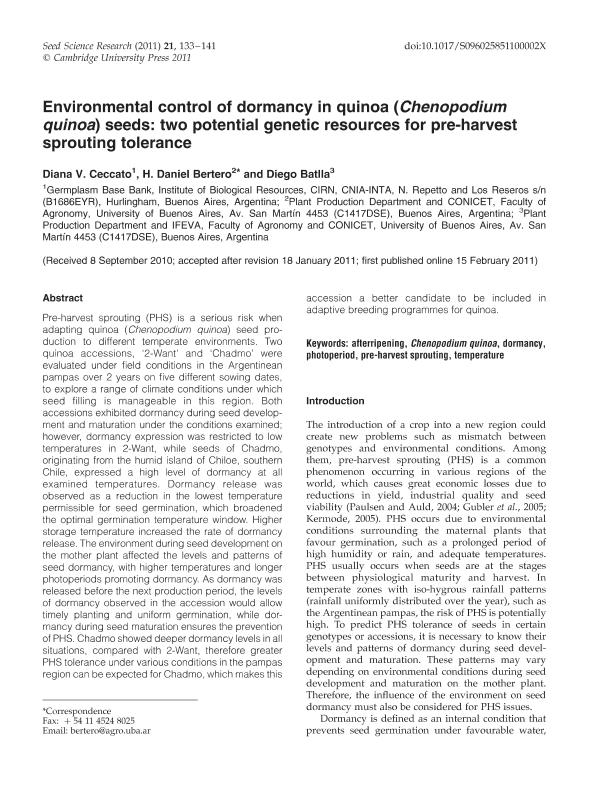Mostrar el registro sencillo del ítem
dc.contributor.author
Ceccato, Diana V.
dc.contributor.author
Bertero, Hector Daniel

dc.contributor.author
Batlla, Diego

dc.date.available
2019-02-25T18:39:31Z
dc.date.issued
2011-06
dc.identifier.citation
Ceccato, Diana V.; Bertero, Hector Daniel; Batlla, Diego; Environmental control of dormancy in quinoa (Chenopodium quinoa) seeds: Two potential genetic resources for pre-harvest sprouting tolerance; Cambridge University Press; Seed Science Research; 21; 2; 6-2011; 133-141
dc.identifier.issn
0960-2585
dc.identifier.uri
http://hdl.handle.net/11336/70799
dc.description.abstract
Pre-harvest sprouting (PHS) is a serious risk when adapting quinoa (Chenopodium quinoa) seed production to different temperate environments. Two quinoa accessions, 2-Want and Chadmo were evaluated under field conditions in the Argentinean pampas over 2 years on five different sowing dates, to explore a range of climate conditions under which seed filling is manageable in this region. Both accessions exhibited dormancy during seed development and maturation under the conditions examined; however, dormancy expression was restricted to low temperatures in 2-Want, while seeds of Chadmo, originating from the humid island of Chiloe, southern Chile, expressed a high level of dormancy at all examined temperatures. Dormancy release was observed as a reduction in the lowest temperature permissible for seed germination, which broadened the optimal germination temperature window. Higher storage temperature increased the rate of dormancy release. The environment during seed development on the mother plant affected the levels and patterns of seed dormancy, with higher temperatures and longer photoperiods promoting dormancy. As dormancy was released before the next production period, the levels of dormancy observed in the accession would allow timely planting and uniform germination, while dormancy during seed maturation ensures the prevention of PHS. Chadmo showed deeper dormancy levels in all situations, compared with 2-Want, therefore greater PHS tolerance under various conditions in the pampas region can be expected for Chadmo, which makes this accession a better candidate to be included in adaptive breeding programmes for quinoa.
dc.format
application/pdf
dc.language.iso
eng
dc.publisher
Cambridge University Press

dc.rights
info:eu-repo/semantics/openAccess
dc.rights.uri
https://creativecommons.org/licenses/by-nc-sa/2.5/ar/
dc.subject
Afterripening
dc.subject
Chenopodium Quinoa
dc.subject
Dormancy
dc.subject
Photoperiod
dc.subject
Pre-Harvest Sprouting
dc.subject
Temperature
dc.subject.classification
Agricultura

dc.subject.classification
Agricultura, Silvicultura y Pesca

dc.subject.classification
CIENCIAS AGRÍCOLAS

dc.title
Environmental control of dormancy in quinoa (Chenopodium quinoa) seeds: Two potential genetic resources for pre-harvest sprouting tolerance
dc.type
info:eu-repo/semantics/article
dc.type
info:ar-repo/semantics/artículo
dc.type
info:eu-repo/semantics/publishedVersion
dc.date.updated
2019-01-29T18:18:50Z
dc.journal.volume
21
dc.journal.number
2
dc.journal.pagination
133-141
dc.journal.pais
Reino Unido

dc.journal.ciudad
Cambridge
dc.description.fil
Fil: Ceccato, Diana V.. Universidad Tecnológica Nacional. Facultad Regional Buenos Aires; Argentina
dc.description.fil
Fil: Bertero, Hector Daniel. Universidad de Buenos Aires. Facultad de Agronomía; Argentina. Consejo Nacional de Investigaciones Científicas y Técnicas; Argentina
dc.description.fil
Fil: Batlla, Diego. Consejo Nacional de Investigaciones Científicas y Técnicas. Oficina de Coordinación Administrativa Parque Centenario. Instituto de Investigaciones Fisiológicas y Ecológicas Vinculadas a la Agricultura. Universidad de Buenos Aires. Facultad de Agronomía; Argentina
dc.journal.title
Seed Science Research

dc.relation.alternativeid
info:eu-repo/semantics/altIdentifier/doi/http://dx.doi.org/10.1017/S096025851100002X
dc.relation.alternativeid
info:eu-repo/semantics/altIdentifier/url/https://www.cambridge.org/core/journals/seed-science-research/article/environmental-control-of-dormancy-in-quinoa-chenopodium-quinoa-seeds-two-potential-genetic-resources-for-preharvest-sprouting-tolerance/648A28954040B42DA44EAB3C0803CC90
Archivos asociados
